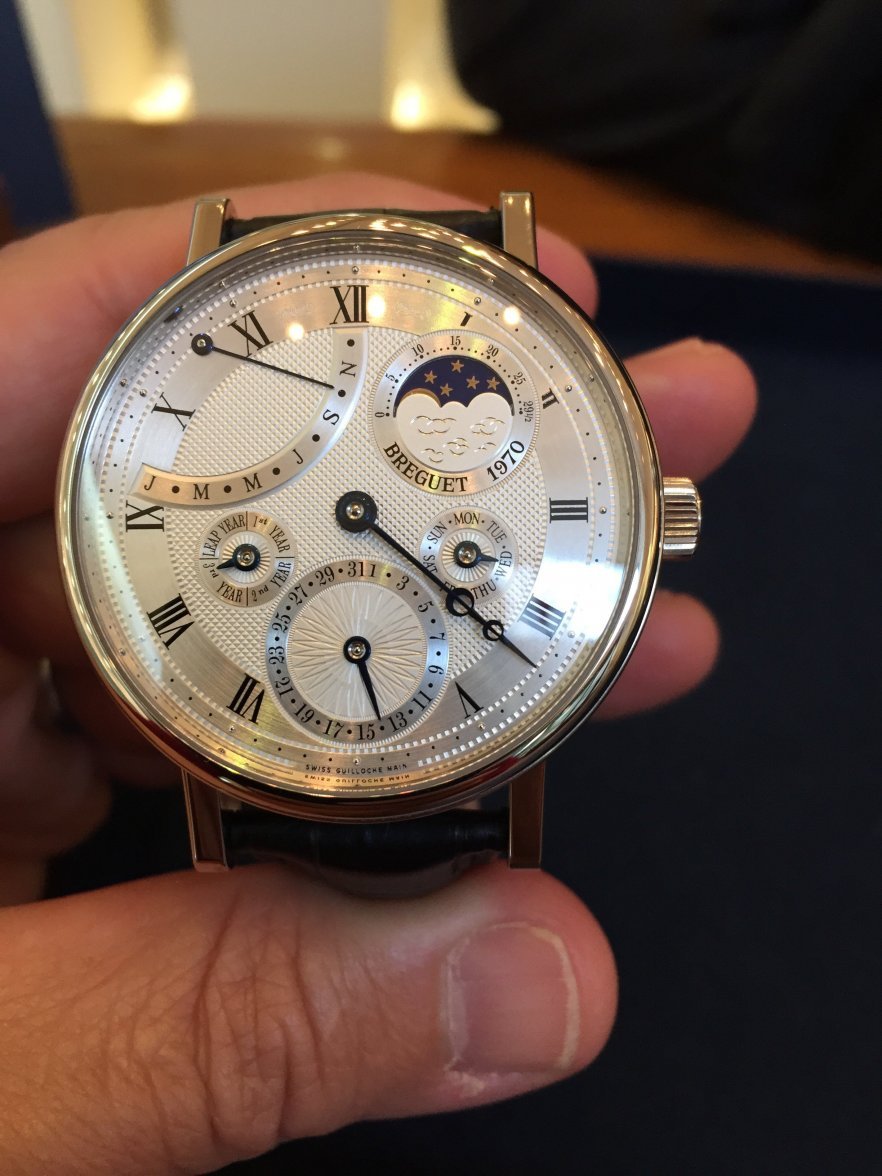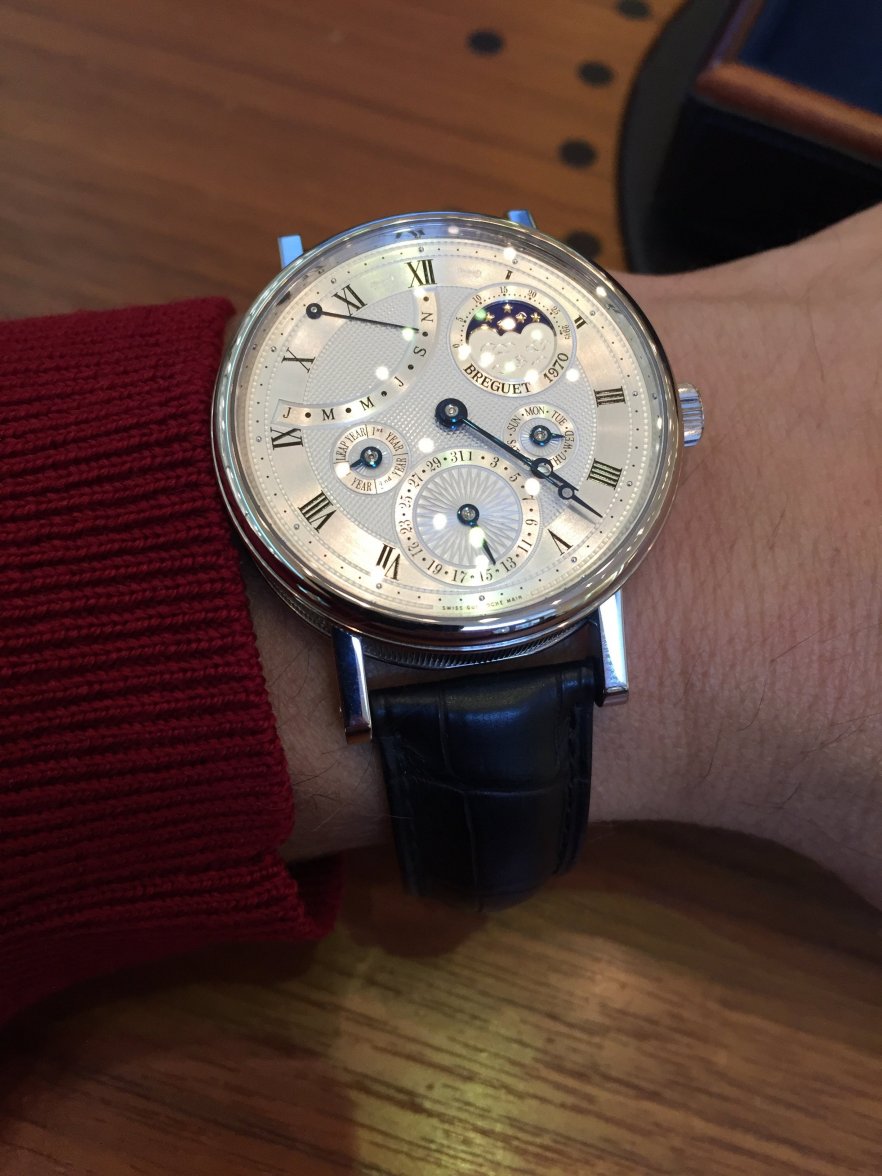Saw some beauties in Chicago
wsfarrell
·The moonphase device on the first two is fabulous!
jcmartinez98
·The moonphase device on the first two is fabulous!
Fer Seamaster
·Ufff! Love those PanoInverses
Archer
··Omega Qualified WatchmakerYes very interesting moon phase. JD makes some beautiful watches, but they tend to wear VERY large. I think most cases in the past have been 43 mm, and with the large dial space and thin bezels, they look huge on your wrist.
Thanks for the pics!
Thanks for the pics!
jcmartinez98
·Yes very interesting moon phase. JD makes some beautiful watches, but they tend to wear VERY large. I think most cases in the past have been 43 mm, and with the large dial space and thin bezels, they look huge on your wrist.
Thanks for the pics!
how can it 'know' what time it is???
Archer
··Omega Qualified Watchmaker@Archer I was hoping you would see these. is it even possible to give a brief description of how in the world the Breguet can chime the hour, quarter hour and minutes?! I was blown away by that complication...
how can it 'know' what time it is???
I don't know what watch you are referring to, and I don't follow Breguet closely enough to know what models they offer. Assuming you are referring to a minute repeater or a sonnerie, these watches can chime the time either on demand (repeater) or just as they run (sonnerie). In some cases watches can do both, so that is a grande sonnerie watch, and quite rare.
Not all repeaters chime down to the minute - some are quarter repeaters that only chime the closest 15 minutes or 1/4 hour, some are 5 minute repeaters, etc.
In a repeater, when the slide is pulled or button pushed, it winds a spring that drives a mechanism inside that has small hammers and gongs that are struck that make the sounds. Video of a pocket watch repeater I had in the shop years ago:
You can likely Google to learn how these work in more detail, so I'm not going to go into great depths here...
How does it know the time? Well there are a few ways to answer this, but the simplest is that it's a watch. 😉
Any watch is a series of gears that travel at a known ratio to each other, so over a given time frame they will move a known amount. If a watch has hands, those hands are in a specific relationship to each other that tells the time. If you have a watch even with just a simple complication like a date, it has to "know" when midnight is by the hand positions. Here the hand positions simply match the rotation of some other parts so that the chime corresponds with the hands. If some watchmaker puts the hands on incorrectly, then the watch no longer "knows" the correct time. It's not magic, just some engineering.
Many consider the tourbillon one of the highest feats in watchmaking, but repeaters are a step above that IMO.
Cheers, Al
jcmartinez98
·I don't know what watch you are referring to, and I don't follow Breguet closely enough to know what models they offer. Assuming you are referring to a minute repeater or a sonnerie, these watches can chime the time either on demand (repeater) or just as they run (sonnerie). In some cases watches can do both, so that is a grande sonnerie watch, and quite rare.
Not all repeaters chime down to the minute - some are quarter repeaters that only chime the closest 15 minutes or 1/4 hour, some are 5 minute repeaters, etc.
In a repeater, when the slide is pulled or button pushed, it winds a spring that drives a mechanism inside that has small hammers and gongs that are struck that make the sounds. Video of a pocket watch repeater I had in the shop years ago:
You can likely Google to learn how these work in more detail, so I'm not going to go into great depths here...
How does it know the time? Well there are a few ways to answer this, but the simplest is that it's a watch. 😉
Any watch is a series of gears that travel at a known ratio to each other, so over a given time frame they will move a known amount. If a watch has hands, those hands are in a specific relationship to each other that tells the time. If you have a watch even with just a simple complication like a date, it has to "know" when midnight is by the hand positions. Here the hand positions simply match the rotation of some other parts so that the chime corresponds with the hands. If some watchmaker puts the hands on incorrectly, then the watch no longer "knows" the correct time. It's not magic, just some engineering.
Many consider the tourbillon one of the highest feats in watchmaking, but repeaters are a step above that IMO.
Cheers, Al
At 4:19, on demand,
It did 4 single chimes, 1 double chime to indicate 15 minutes, then 4 more single chimes to indicate the "excess"
I was blown away
Thanks for the video.
vinn2
·FANTASTIC VIDEO. when i bought -1st - sieko, the jewle_ showed me one. a ship captains pocket watch
- Posts
- 159
- Likes
- 184
CMG23
·@Archer I was hoping you would see these. is it even possible to give a brief description of how in the world the Breguet can chime the hour, quarter hour and minutes?! I was blown away by that complication...
how can it 'know' what time it is???
Thats an exquisite Breguet you have you in your hands. Minute repeater/Perpetual Calendar/moon phase in Platinum.. That is a 300k+ watch you had in your hand.
jcmartinez98
·C nmttd2Thats an exquisite Breguet you have you in your hands. Minute repeater/Perpetual Calendar/moon phase in Platinum.. That is a 300k+ watch you had in your hand.
315k
vinn2
·"---- "and all the ships at sea" --- i was told years ago, the repeater was used by sailing ship masters to tell the time without exposing a time piece to "north sea weather" as an improvment on the "hour glass and the bell" so ---- it seems that a complicated, large, pocket watch movement has been replaced with a quartz and transister,AND water proof wrist watch. wow
Similar threads
- Posts
- 15
- Views
- 6K
- Posts
- 16
- Views
- 9K




